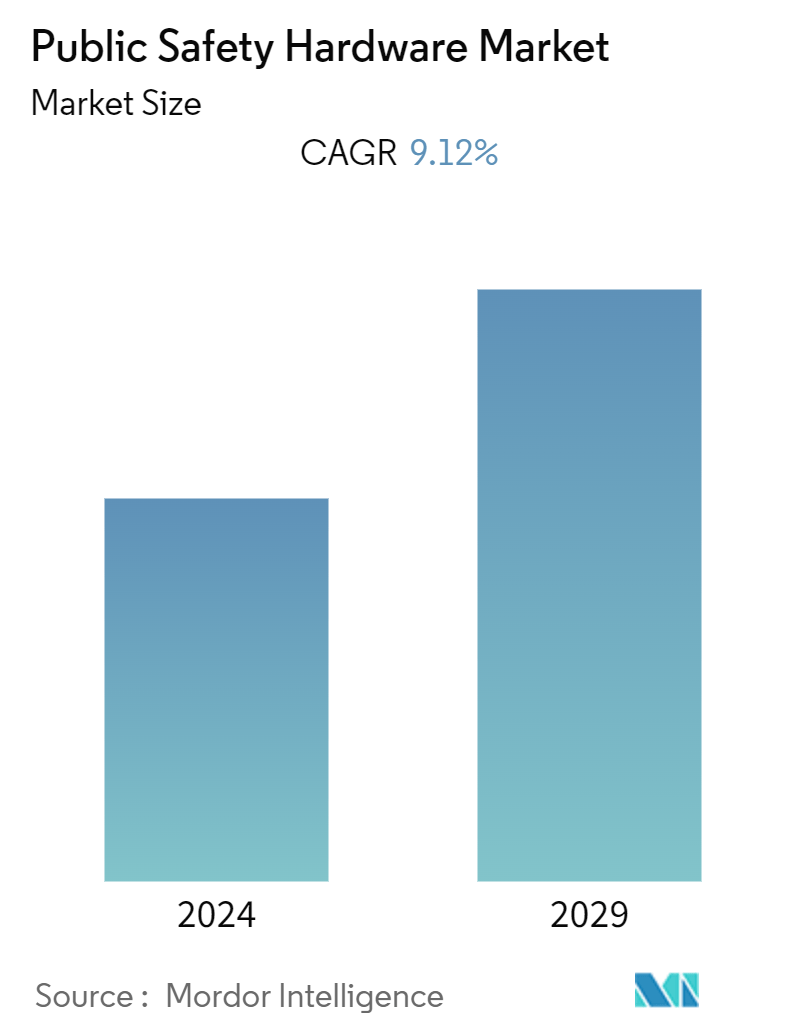Market Size of Public Safety Hardware Industry

| Study Period | 2019 - 2029 |
| Base Year For Estimation | 2023 |
| CAGR (2024 - 2029) | 9.12 % |
| Fastest Growing Market | Asia Pacific |
| Largest Market | North America |
| Market Concentration | Low |
Major Players
*Disclaimer: Major Players sorted in no particular order |
Public Safety Hardware Market Analysis
The Public Safety Hardware Market is expected to register a CAGR of 9.12% during the forecast period.
The market for public safety hardware is driven by the increasing use of technologies such as AI and analytics in law enforcement, as well as growing investments in public safety-related projects.
- Rapid urbanization spurs the demand for commercial, residential, and infrastructure projects, drawing a larger population to urban centers. This growth necessitates the construction of tall buildings, housing units, multiplexes, and transportation networks, all aimed at accommodating the rising populace and bolstering economic progress. Consequently, infrastructure development is a key driver, fueling the demand for surveillance cameras.
- The advent of 5G technology, with its reduced latency and high data speeds, is a pivotal growth driver. Its swift data transfer capabilities facilitate the seamless transmission of large video files from surveillance cameras to monitoring centers or cloud storage. Moreover, the increasing integration of AI in cameras, enabling real-time video analysis, is revolutionizing the market. AI-powered cameras offer advanced features like facial recognition, object detection, and behavioral analysis, significantly enhancing surveillance system efficiency.
- The growing advancements are set to boost market growth. For instance, in May 2024, Teledyne FLIR launched the Trafibot AI 4K visible camera system, designed specifically for intercity traffic intelligence. This closed-circuit camera harnesses advanced artificial intelligence, ensuring top-tier detection capabilities and reliable data collection on intercity routes from highways to tunnels. It maintains high image resolution and minimizes data loss, even in bandwidth-constrained scenarios. Paired with Teledyne's renowned 3D global tracker, FLIR, the Trafibot AI camera boasts enhanced incident detection. It can predict the speed and trajectory of vehicles as they enter their field of view, even when these objects are partially obscured by other vehicles or road elements.
- Organizations and government agencies in countries such as Saudi Arabia have become more aware of the potential risks and consequences of security threats. This increased awareness has led to a proactive approach to security, focusing on advanced monitoring systems as a key component of overall security strategies. For instance, in May 2023, Saudi Arabia’s public security department announced the implementation of automated surveillance of seven traffic infractions. These violations include driving on sidewalks or pedestrian paths where driving is prohibited, failing to use the proper lighting when driving at night or in poor visibility conditions, and failing to keep trucks and other large vehicles in the right lane on multi-lane roads. Traffic laws are also automatically monitored, as are driving with covered or damaged license plates and avoiding the station that measures the weights and dimensions of vehicles. It exemplifies the importance of advanced monitoring systems, which are becoming increasingly integral to maintaining security and order in various sectors, including traffic management and law enforcement in Saudi Arabia.
- Further, rapid urbanization has led to the development of smart cities and large-scale infrastructure projects. These urban environments require sophisticated electronic security solutions to ensure the safety and security of residents, businesses, and visitors. As a result, advanced monitoring systems are crucial in creating secure and efficient urban spaces.
- The market growth is likely to be hampered by the substantial upfront expenses associated with installing surveillance cameras. Establishing a robust surveillance network demands a hefty outlay on top-tier cameras, storage units, networking gear, and ancillary tools. Beyond the hardware outlay, ancillary costs like labor, cabling, and system integration add to the initial financial burden. Such costs can be particularly challenging for budget-constrained organizations, complicating the ROI evaluation.
Public Safety Hardware Industry Segmentation
The global public safety hardware market tracks the revenue generated from public safety hardware devices/solutions offered by various market players.
The global public safety hardware market is segmented by type (security and dashboard cameras, rugged tablets and wearable devices, and infrastructure safety devices), application area (law enforcement, emergency services, military, infrastructure security, and disaster management), and geography (North America, Europe, Asia-Pacific, Latin America, and the Middle East and Africa). The report offers market sizes and forecasts for all the above segments in terms of value (USD).
| By Type | |
| Security and Dashboard Cameras | |
| Rugged Tablets and wearable devices | |
| Infrastructure Safety devices | |
| Others |
| By Application | |
| Law Enforcement | |
| Emergency Services | |
| Military | |
| Infrastructure Security | |
| Disaster Management | |
| Others |
| By Geography*** | |
| North America | |
| Europe | |
| Asia | |
| Latin America | |
| Middle East and Africa |
Public Safety Hardware Market Size Summary
The Public Safety Hardware Market is poised for significant growth, driven by the integration of advanced technologies like artificial intelligence and analytics in law enforcement and increased investments in public safety initiatives. The rapid urbanization and the consequent need for extensive infrastructure development, including tall buildings and transportation networks, are key factors propelling the demand for surveillance systems. The introduction of 5G technology, with its high-speed data transfer capabilities, is further enhancing the market by enabling real-time video analysis and seamless data transmission from surveillance cameras to monitoring centers. This technological advancement is revolutionizing surveillance systems, making them more efficient with features such as facial recognition and behavioral analysis. The market is also witnessing proactive security measures in countries like Saudi Arabia, where automated surveillance systems are being implemented to monitor traffic violations, underscoring the growing importance of advanced monitoring solutions in maintaining public safety.
In North America, the adoption of surveillance cameras is on the rise due to heightened security concerns and the need for enhanced safety measures. The aging public safety infrastructure in the United States has prompted significant investments in upgrades, with federal and state governments allocating substantial funds to modernize public safety communication and infrastructure. This trend is reflected in initiatives like the FirstNet Authority's partnership with AT&T, aimed at expanding public safety coverage. The market is semi-consolidated, with major players such as Motorola Solutions and Teledyne FLIR launching innovative products to bolster market growth. These developments highlight the critical role of public safety hardware in safeguarding communities and the ongoing commitment to integrating advanced technologies for improved security and efficiency.
Public Safety Hardware Market Size - Table of Contents
-
1. MARKET INSIGHTS
-
1.1 Market Overview
-
1.2 Ecosystem Analysis
-
1.3 Porters Five Force Analysis
-
1.3.1 Bargaining Power of Buyers/Consumers
-
1.3.2 Bargaining Power of Suppliers
-
1.3.3 Threat of New Entrants
-
1.3.4 Threat of Substitute Products
-
1.3.5 Intensity of Competitive Rivalry
-
-
1.4 Analysis of macro-economic scenarios
-
-
2. MARKET SEGMENTATION
-
2.1 By Type
-
2.1.1 Security and Dashboard Cameras
-
2.1.2 Rugged Tablets and wearable devices
-
2.1.3 Infrastructure Safety devices
-
2.1.4 Others
-
-
2.2 By Application
-
2.2.1 Law Enforcement
-
2.2.2 Emergency Services
-
2.2.3 Military
-
2.2.4 Infrastructure Security
-
2.2.5 Disaster Management
-
2.2.6 Others
-
-
2.3 By Geography***
-
2.3.1 North America
-
2.3.2 Europe
-
2.3.3 Asia
-
2.3.4 Latin America
-
2.3.5 Middle East and Africa
-
-
Public Safety Hardware Market Size FAQs
What is the current Public Safety Hardware Market size?
The Public Safety Hardware Market is projected to register a CAGR of 9.12% during the forecast period (2024-2029)
Who are the key players in Public Safety Hardware Market?
Motorola Solutions, Teledyne FLIR LLC, L3Harris, Honeywell International Inc. and Icom America are the major companies operating in the Public Safety Hardware Market.

